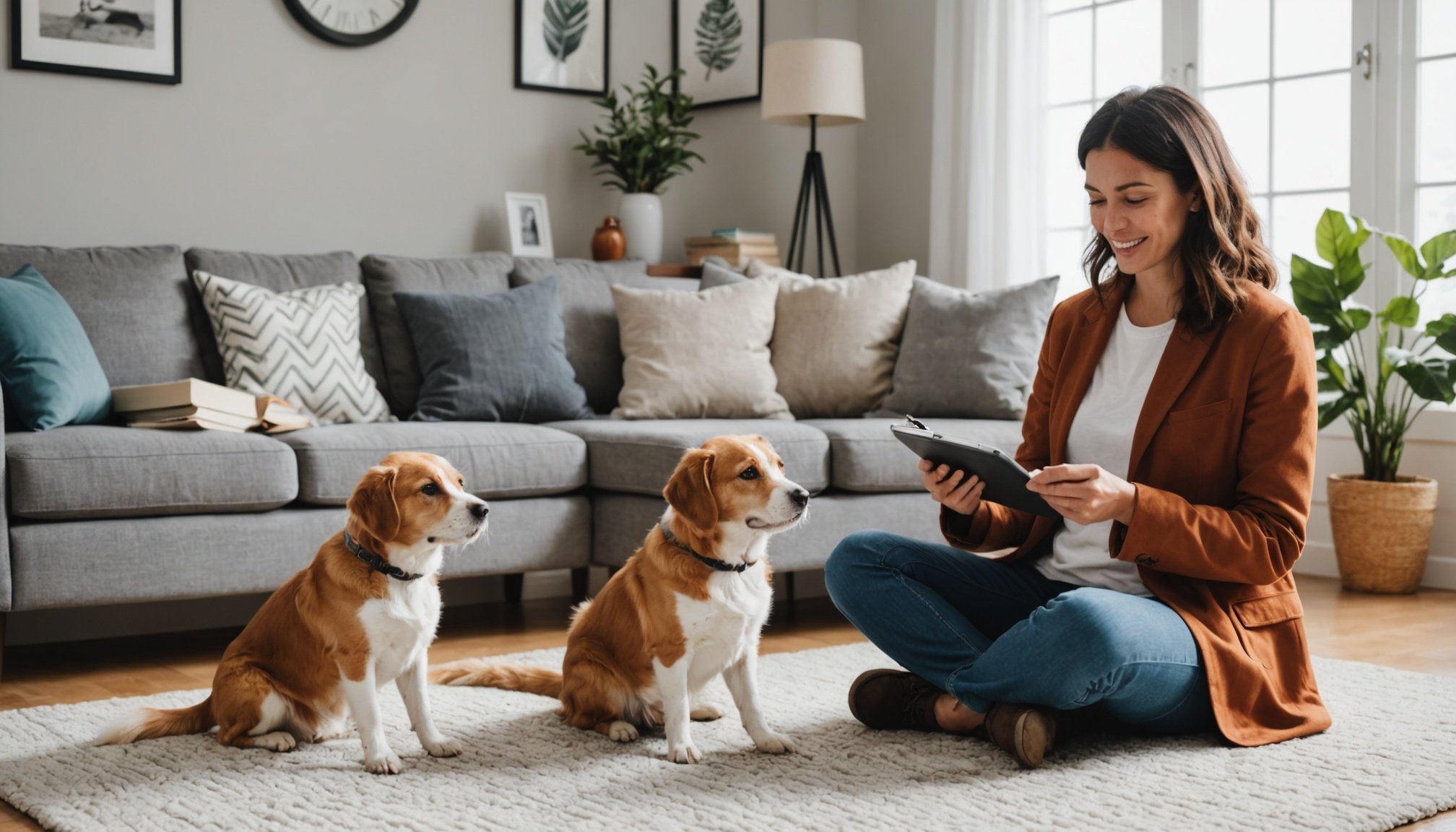Importance of a Harmonious Routine
Creating a harmonious routine is fundamental for the overall wellbeing of both pets and owners. For pets, having a structured routine reduces anxiety and promotes healthier behaviors, leading to enhanced pet happiness. Predictability gives pets a sense of security, significantly helping in managing their stress levels. For instance, knowing when they will be fed or taken for walks leads to less nervous behavior.
On the owner’s side, a well-defined routine improves time management and boosts overall owner satisfaction. By allocating specific times for pet care, owners can manage their daily tasks more efficiently, reducing stress and allowing more quality time with their pets. This nurturing environment not only heightens the bond but also supports the mental and physical health of both parties.
In the same genre : What Should You Know About Pet Adoption in the UK?
Routines provide numerous benefits, including:
- Improved pet behavior due to reduced stress
- Enhanced owner satisfaction by efficiently managing daily tasks
- Stronger pet-owner relationships through shared activities
By understanding the profound impact routines have on daily life, one can cultivate a stable environment that celebrates the joys of pet ownership while ensuring pet happiness and a stress-free lifestyle for the family.
In parallel : What Should You Know About Pet Adoption in the UK?
Establishing a Daily Schedule
Creating a daily routine is paramount for managing daily activities effectively, both for pet welfare and owner convenience. A consistent schedule not only fosters time management but also boosts pet happiness and owner satisfaction. Determining a balanced daily schedule involves planning specific times for feeding, walking, and playtime, ensuring each activity aligns with the pet’s natural rhythms and needs.
For example, a sample daily schedule might include morning walks to energize pets, followed by a nutritious breakfast. Midday activities could involve interactive play sessions or nap times. Evening routines might focus on leisurely strolls or quiet bonding activities. Such times should remain as consistent as possible to maintain a harmonious routine.
The significance of consistency cannot be overstated. It helps pets anticipate what comes next, reducing anxiety and making transitions smoother. Thus, structured routines serve as reliable frameworks that alleviate stress for both pets and owners. Maintaining set times fosters a sense of security and structure that pets thrive on, which in turn enhances overall well-being. Consistency, coupled with flexibility to address unexpected changes, leads to a more enjoyable and manageable daily experience for everyone involved.
Feeding and Nutrition
Establishing regular feeding times is crucial to supporting pet health and well-being. Maintaining a consistent schedule helps regulate pets’ digestive systems, preventing overeating and obesity. Precise feeding slots offer pets predictability, which is comforting and fulfills their innate need for routine.
Choosing the right food is also essential and should be based on the pet’s age, size, and dietary needs. Puppies and kittens require nutrient-rich diets designed for growth, whereas older pets may benefit from formulas that support joint health and manage calorie intake. Researching food options and consulting with veterinarians can provide valuable guidance tailored to your pet’s specific needs.
Training during meal times can enhance pet engagement and reinforce good behavior. Simple commands like “sit” or “stay” before meals teach patience and can improve overall discipline. This process combines nourishment with mental stimulation, aligning with your pet’s natural instincts.
Incorporating these strategies not only optimizes your pet’s nutrition but also facilitates healthier daily interactions. By adopting and maintaining structured feeding practices, owners can see improvements in their pets’ health, happiness, and overall quality of life, ensuring a robust foundation for long-term well-being.
Exercise and Playtime
Pet exercise plays a critical role in maintaining the health and happiness of both pets and their owners. Regular, structured daily play ensures that pets remain active, helping to prevent obesity and related health issues. For dogs, activities such as walks, fetch, and agility training are both mentally and physically stimulating. Cats, on the other hand, might enjoy interactive toys that mimic hunting behaviors, offering both physical exercise and mental stimulation.
Incorporating bonding activities into pet exercise routines strengthens the pet-owner relationship. Simple actions, like spending quality time in the park or engaging in a game of tug-of-war, foster trust and communication between pets and their humans. Moreover, such interactions provide a great opportunity for owners to observe and understand their pet’s unique personality traits and preferences.
Equally important is the impact of mental stimulation. Engaging activities that challenge pets’ minds can improve their behavior and reduce anxiety, leading to a more peaceful home environment. Puzzle toys and hide-and-seek games promote problem-solving skills and keep pets entertained for extended periods. A balanced approach, combining both physical exertion and mental challenges, ensures pets lead a well-rounded lifestyle. This balance ultimately contributes to better overall pet behavior and happiness.
Managing Stress for Pets and Owners
Navigating stress in our lives is a challenge all too familiar, and it extends to our furry companions as well. Recognizing common stress triggers for pets is the first step in creating a calm environment. Loud noises, unfamiliar visitors, and sudden changes in routine can unsettle pets, leading to anxiety. To mitigate these triggers, maintain a predictable environment where possible. Introduce changes gradually to help pets adjust calmly.
For pet owners, managing their own stress is crucial, as it directly impacts pet wellbeing. Engaging in relaxation techniques, such as deep breathing or meditation, not only benefits you but also contributes to a tranquil home atmosphere. Reserve quiet moments for both you and your pet, perhaps winding down with a book while your pet rests beside you.
Creating a calm space is vital, especially amid a bustling household. Designate a cozy nook for your pet to retreat to when seeking solitude. Consistent quiet times in this sanctuary can significantly alleviate anxiety. Enriching this space with favourite toys or a comforting blanket further enhances their sense of security, contributing positively to both pet happiness and owner satisfaction.
Positive Interaction Strategies
In nurturing a thriving pet-owner relationship, understanding the role of positive reinforcement is vital. This approach uses praise, treats, or affection to encourage good behavior. For example, rewarding a dog with a treat for sitting on command reinforces this action, making it more likely to recur. Positive reinforcement boosts pet confidence and promotes a happy training environment, creating a stronger bond with their human companions.
Effective training techniques such as clicker training can enhance communication. This method uses a click sound to mark desirable behavior, followed by a reward, aiding clear interaction between pets and owners. Training sessions should be brief and engaging, maintaining the pet’s interest without causing stress. Consistency in these techniques results in more responsive and disciplined pets, improving overall harmony in the household.
Routine interactions like grooming and cuddling further deepen the connection. Such activities provide opportunities for quality time, fostering trust and affection. Regular grooming keeps pets physically healthy while supplying calm, shared experiences that strengthen ties. Cuddling, meanwhile, offers comfort and reassurance, combatting loneliness for pets and humans alike. Emphasizing these positive strategies ensures happier, well-adjusted pets and contented owners, enhancing the joy of companionship.
Addressing Common Challenges
Even the most meticulously planned routine can encounter unforeseen disruptions. Pet owners often face challenges like sudden schedule changes or unexpected events, which can complicate maintaining a stable daily routine. Solutions involve a flexible approach, allowing adaptation while retaining core elements of established schedules. For example, prioritizing key activities ensures continuity, such as adjusting feeding or walking times rather than skipping them entirely.
Embracing a solution-oriented mindset is crucial. Consider utilizing technology, such as scheduling apps, to reschedule tasks efficiently. Community support, like pet-sitting services or swap arrangements with fellow pet owners, can provide relief during busy periods. Such strategies ensure that both pet happiness and owner satisfaction remain intact, despite temporary disturbances.
Sharing and learning from others’ experiences can prove invaluable. Real-life stories of pet owners navigating routine disruptions successfully demonstrate resilience and adaptability. These narratives, typically involving minor routine adjustments like rotating playtimes or delegating tasks within a household, underscore the importance of preparation and community.
By employing these pragmatic approaches, pet owners can seamlessly manage routine challenges, maintaining a harmonious environment that supports the well-being of pets and a fulfilling experience for owners.
Visuals and Checklists for Routines
Organizing your pet care tasks can become seamless with the use of visual aids and routine checklists. By leveraging these tools, pet owners can maintain a well-structured schedule, enhancing both owner satisfaction and pet happiness. Visual reminders, such as wall charts or smartphone apps, can help track key activities like feeding, walking, and playtime, ensuring no detail is overlooked.
Utilizing routine checklists offers several benefits, including improved time management and reduced stress. These lists provide a tangible way to sequence tasks, making it easier to integrate pet care into daily life. Checklists also allow for customization according to your specific routines, ensuring adaptability and precision.
To further boost efficiency, consider leveraging apps designed specifically for schedule management. Apps can offer notifications, track progress, and adapt to changes, allowing for a flexible yet consistent approach to pet care. Notable tools can include features like reminders for vet appointments, medication schedules, and grooming tasks.
A well-crafted combination of visual aids and digital tools can streamline your routines, supporting a balanced lifestyle that honours both you and your pet’s needs. Embracing these strategies ultimately contributes to a healthier, happier home for all.



